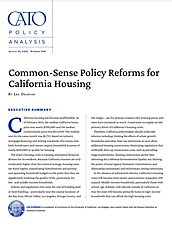The state’s housing crisis is creating substantial financial distress for its residents. Because California incomes are only moderately higher than the national average, housing costs are much higher, exacerbating homelessness and poverty and squeezing household budgets to the point that they are significantly lowering the quality of life, particularly for low- and middle-income households.
Policies and regulations that raise the cost of building and/or limit building—particularly near the coastal locations of the Bay Area, Silicon Valley, Los Angeles, Orange County, and San Diego—are the primary reasons why housing prices and rents have increased so much. Constraints on supply are the primary driver of California’s housing crisis.
Therefore, California policymakers should undertake reforms, including: limiting the effects of urban-growth boundaries and other land-use restrictions so as to allow additional housing construction; eliminating regulations that artificially drive up construction costs, such as prevailing-wage requirements; limiting construction permit fees; reforming the California Environmental Quality Act; limiting the power of Local Agency Formation Commissions; and eliminating unnecessary and exclusionary zoning restrictions.
In the absence of substantial reforms, California’s housing crisis will become more severe and economic inequality will expand. Middle-income households, particularly those with school-age children, will relocate outside of California so that the state will become primarily home to high-income households that can afford the high housing costs.





